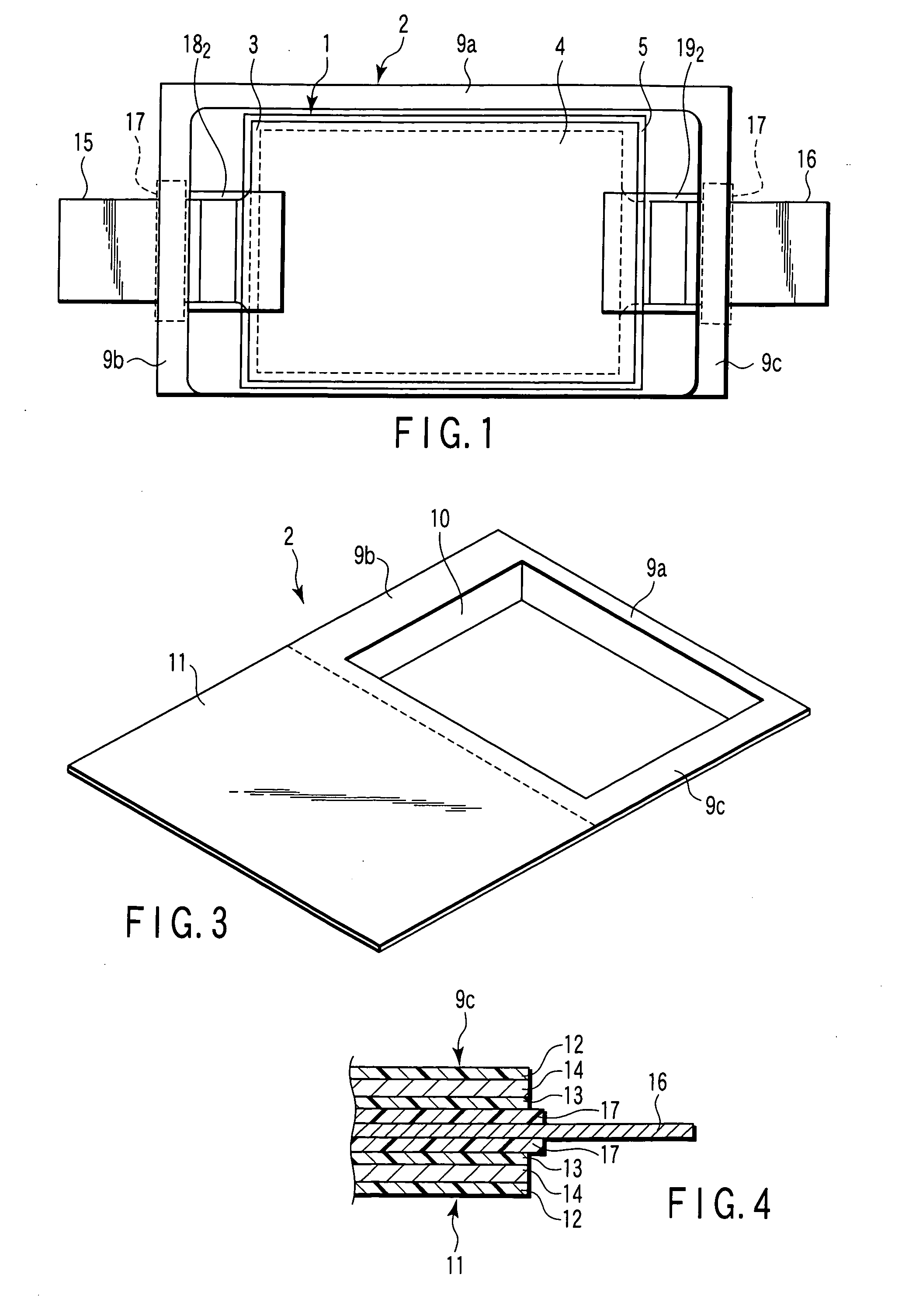Nonaqueous electrolyte battery, battery pack and vehicle
a technology of electrolyte batteries and battery packs, applied in the field of nonaqueous electrolyte batteries, battery packs and vehicles, can solve the problems of substantially impossible to suppress the movement of the electrode group within the case, the mechanical strength of the electrode current collector is relatively small in many cases, and the movement of the electrode group inside the case is not easy to achiev
- Summary
- Abstract
- Description
- Claims
- Application Information
AI Technical Summary
Benefits of technology
Problems solved by technology
Method used
Image
Examples
first embodiment
[0061] FIGS. 1 to 6 collectively show the nonaqueous electrolyte battery according to a first embodiment of the present invention, wherein FIG. 1 is a planar perspective view showing the construction of a flattened nonaqueous electrolyte battery according to the first embodiment of the present invention, FIG. 2 is a vertical cross sectional view of the nonaqueous electrolyte battery shown in FIG. 1, FIG. 3 is an oblique view schematically showing the case included in the nonaqueous electrolyte battery shown in FIG. 1, FIG. 4 is a cross sectional view showing in a magnified fashion the construction of the sealing portion of the nonaqueous electrolyte battery shown in FIG. 1, FIG. 5 is a perspective view showing the construction of the nonaqueous electrolyte battery shown in FIG. 1 as viewed in the extending direction of the positive electrode terminal, and FIG. 6 is a perspective view showing the construction of the nonaqueous electrolyte battery shown in FIG. 1 as viewed in the exte...
second embodiment
[0089] A nonaqueous electrolyte battery according to a second embodiment of the present invention is equal in construction to the nonaqueous electrolyte battery according to the first embodiment described above, except that, in the second embodiment, an insulating spacer is used as the insulating member in place of the insulating film used in the first embodiment.
[0090] It is possible to use, for example, polypropylene, polyethylene, polyethylene terephthalate, polyphenylene sulfide, polyimide, or polytetrafluoro ethylene (PTFE) as a material of the insulating spacer. Also, it is desirable for the insulating spacer to be formed of a material having a melting point higher than that of the inner surface of the case.
[0091] The nonaqueous electrolyte battery according to the second embodiment of the present invention will now be described with reference to FIGS. 8 to 11. Incidentally, the reference numerals put in FIGS. 1 to 7 are also put to the same members of the nonaqueous electro...
third embodiment
[0101] A third embodiment of the present invention is directed to a nonaqueous electrolyte battery in which the positive electrode terminal and the negative electrode terminal are drawn in the same direction. Specifically, FIG. 15 is a planar perspective view showing the construction of a flattened nonaqueous electrolyte battery according to the third embodiment of the present invention, in which the positive electrode terminal and the negative electrode terminal are drawn in the same direction, and FIG. 16 is a vertical cross sectional view showing the construction of the nonaqueous electrolyte battery shown in FIG. 15. Incidentally, the reference numerals put in FIGS. 1 to 7 are also put to the same members of the nonaqueous electrolyte battery shown in FIGS. 15 and 16 so as to avoid the description thereof.
[0102] A flattened electrode group (power generating element) 1 is housed in a case 2. As shown in FIG. 15, the case 2 comprises a container 10 having longer side edge portion...
PUM
 Login to View More
Login to View More Abstract
Description
Claims
Application Information
 Login to View More
Login to View More - R&D
- Intellectual Property
- Life Sciences
- Materials
- Tech Scout
- Unparalleled Data Quality
- Higher Quality Content
- 60% Fewer Hallucinations
Browse by: Latest US Patents, China's latest patents, Technical Efficacy Thesaurus, Application Domain, Technology Topic, Popular Technical Reports.
© 2025 PatSnap. All rights reserved.Legal|Privacy policy|Modern Slavery Act Transparency Statement|Sitemap|About US| Contact US: help@patsnap.com



